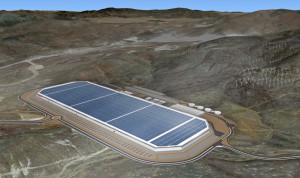Tesla’s been a groundbreaking company on many levels since its inception and now the company is looking to set a new benchmark on ground its already broken: the world’s largest solar array on the roof of its under-construction Gigafactory.
The California-based EV maker is planning to create a 70-megawatt rooftop installation of solar panels that will provide the facility with all of its power needs and will, once completed, nearly seven times bigger than the next biggest rooftop array.
While this may sound like a rather expensive proposition, Tesla’s acquisition of SolarCity, the solar panel manufacturer, will more than offset the costs associated with producing the panels needed to generate the power for the plant.
Additionally, for those rare non-sunny days in the desert outside of Reno, Nevada, where the plant is located, Tesla will use its powerwall storage systems to capture any extra electricity generated by the system.
(Tesla misses mark on deliveries. Click Here for details.)
Tesla executives have said the new place will run completely on renewable energy sources, and that includes the heating system. Using a closed-loop system to save water, the company will heat the Gigafactory using waste heat, according to Electrek.
According to a document Tesla is giving to investors as part of the facility tour, the company is lowering operational costs and the cost of cells and batteries, Autoblog reports, adding that Tesla says the plant will have 35 GWh of annual cell production capacity and 50 GWh of battery production capacity by the end of its current construction phase.
(Click Here for more about the first three owners taking delivery of their new Chevy Bolts.)
As the changes on the every growing Gigafactory continue, the automaker is also making some changes that will may result in some happier Model S owners. When the buyers of the Model S 60 make their purchase, they have to option to upgrade to the Model S 75 at a later date.
Both vehicles use 75 kwh batteries, but the difference is a slight upgrade in terms of acceleration, top speed and battery life per charge. The initial price difference is $6,500; however, if the buyers upgrade later, that price jumps to $9,000.
(To see more about Tesla’s Autopilot update, Click Here.)
That said, a recently perusal of the Tesla website shows the company has knocked $2,000 off the upgrade from the 60 to the 75 to just $7,000. While it’s still $500 cheaper to make the change at the purchase point, a discount is a discount.

